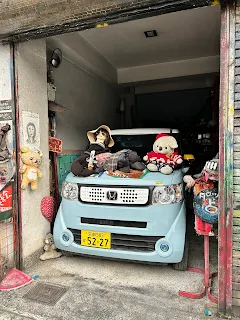First Blog Post: On the way to Japan Tokyo -Day 1
Second Blog Post : On the way to Japan - visiting Fuji-san
Third Blog Post: Tour to Mount Hakone and Ashi Lake
Seventh Blog Post: Kyoto Temple Pilgrimage - Temple of the Thousand Buddhas, Bamboo Forest, Zen Temple, Golden Temple, and Shinto Shrine.
Eighth blog post: Last day in kyoto and Deers of Nara
Ninth blog post: A train lover's best day
This is the other part of the story about going to the Railway Museum. In addition to the room Ines was staying in at our hotel, I booked another room. Outside that room was a track for intercity trains. Videos of it are on my YouTube channel.
This is the YouTube video of it.
We were supposed to go to Osaka by bullet train. It travels at 285 miles per hour, taking only fifteen minutes. But what's the use? We saw a special slow tourist train going on the same day. Japan has such trains. There are beautiful train services that go slowly, allowing tourists to enjoy the scenery. They don't cost much either—the same price as a regular ticket. "Tourists" doesn't just mean foreigners; Japanese people also take these train journeys quite a lot.
I called the travel agent. They told us we would lose the two Shinkansen bullet train tickets. But because of my train obsession, Ines agreed to go to Osaka and then come back to Kyoto on that slow train. So, that's what we did. As soon as we arrived in Osaka, we dropped our bags at the hotel and went to the Osaka Umeda station, where the regular trains run.
I videoed that train arriving at the platform. I also videoed the route to Kyoto from inside the first carriage. All of these are available on my YouTube channel for anyone interested. I'll just put one here.
I videoed almost the entire journey from Osaka to Kyoto and Kyoto to Osaka from the first carriage. The journey there was in the rain. These are electric trains, similar to the "Electrichka" trains they had in Russia.
Inside these trains, they've placed potted plants, hung beautiful pictures like in a house, and added various decorations. It reminded me of the decorated buses in Sri Lanka. I thought, "It's fine as long as they don't obstruct people or cause fatalities, right?" However, the carriages on these Japanese trains are decorated in a more orderly fashion. The pictures will make that clear. This is the slideshow.
The suspicion about Japanese people being racist came because people wouldn't sit next to me. On bullet trains where we hadn't booked seats, we sort of forced ourselves into seats where bags were placed. They moved their bags and made space. However, many people on three-seater rows leave the middle seat empty, respecting the other person's space. But on this train, it became clear to me that you can turn the seats around if you want, allowing you to travel freely and peacefully.
Another thing that stands out is the quietness. No one shouts into their mobiles or takes calls. On the train, you can read a book, talk softly, or just look outside. People here appreciate that.
We met a teacher who lived outside the city in a rather large house. She said that many people leave such homes and move to places where there are jobs.
The last picture shows where we went for lunch. You don't need to put your bags on the floor; there are wicker baskets for them. I didn't take pictures of the food, but it was fried chicken and small salads. We ate because we were hungry.
On our second day in Osaka, we went on a tour. Since the prices of the items there were very high, I thought I'd share some pictures and details about them.
You know Steve Jobs, the creator of the Apple iPhone. Every time he came to Japan, he would visit a special person. Steve Jobs was very fond of Japan. When he started creating the Apple iPhone, he used many Japanese manufacturing methods.
In Japan, people with exceptional skills in a particular manufacturing task—engineers, designers, etc.—are called Takumi. In English, you could call them artisans or craftsmen, but that word isn't really enough. This is because sometimes that skill comes from intense dedication. Only in Japan do they make the turntable needles that can play records. Only those who know how to make these machines work correctly are left there now.
You can see these items are generally quite expensive. I'm bringing this up because of something I saw when we went to an Osaka shopping center the next day. There are special shops that sell these kinds of rarely produced fruits, sake, and drinks. They are quite pricey. However, these are made by specialized "Takumi" (artisans) who are specially trained for them.
It's apparently a Japanese custom to buy such expensive items as gifts for birthdays, for a boss at work, or for a special day for parents. There are two watermelons here that cost about £160. These are grown very carefully on a separate vine, and they reportedly taste different. But then again, they're probably best suited for the Japanese palate!
As for the whiskey, I bought a small set of bottles. This is because one bottle can cost upwards of £100, and even if I bought it, there wouldn't be space to carry it. An 18-year-old Yamazaki whiskey costs around £600, while a 12-year-old one is available for £150. The 12-year-old has a somewhat strong taste, while the others are very smooth.























